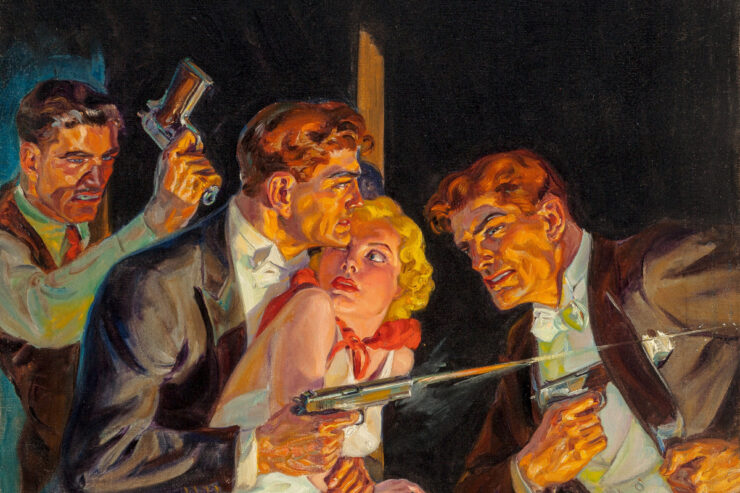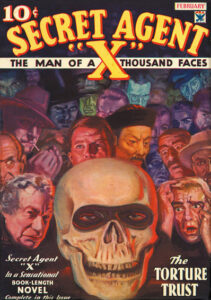 Riding the wave of hero pulps that The Shadow Magazine kicked off in 1931, Secret Agent X hit newsstands with a first issue dated February 1934. “The Man of a Thousand Faces” was on the scene two months before Operator #5, “America’s Undercover Ace,” who also arrived to protect the United States in April 1934.
Riding the wave of hero pulps that The Shadow Magazine kicked off in 1931, Secret Agent X hit newsstands with a first issue dated February 1934. “The Man of a Thousand Faces” was on the scene two months before Operator #5, “America’s Undercover Ace,” who also arrived to protect the United States in April 1934.
Agent X developed his spy skills in the Intelligence Service during World War I, rising to lieutenant colonel before the war ended. Instead of returning to civilian life, he accepted an offer made by a high-ranking government official to become a freelance agent, combating crime anywhere in the United States.
His adventures appeared in 41 novels from 1934 through March 1939, all credited to the house name Brant House. The magazine was edited by Rose Wyn.
Paul Chadwick wrote the first five novels before Emile C. Tepperman contributed the sixth story. Chadwick would go on to write 9 more Secret Agent X novels, while Tepperman would produce another three. Later in the series, Wayne Rogers would write a single adventure for the December 1937 issue of Secret Agent X.
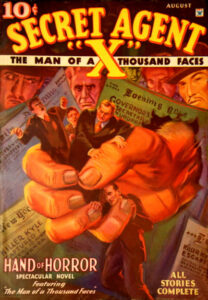 G. T. Fleming-Roberts, however, penned the majority of Agent X’s adventures, 22 out of 41. The author had previously contributed four stories to the Ace pulp and twice that many to Ten Detective Aces when he penned “The Corpse Cavalcade” for the June 1935 issue of Secret Agent X. He would later write the lead novels for The Green Ghost, G-Men Detective, Hooded Detective, and the final hero pulp, Captain Zero. He also wrote many stories for the detective pulps, including the Jeffrey Wren series for Dime Detective, Diamondstone for Popular Detective, and the Pat Oberron stories for Big-Book Detective and New Detective.
G. T. Fleming-Roberts, however, penned the majority of Agent X’s adventures, 22 out of 41. The author had previously contributed four stories to the Ace pulp and twice that many to Ten Detective Aces when he penned “The Corpse Cavalcade” for the June 1935 issue of Secret Agent X. He would later write the lead novels for The Green Ghost, G-Men Detective, Hooded Detective, and the final hero pulp, Captain Zero. He also wrote many stories for the detective pulps, including the Jeffrey Wren series for Dime Detective, Diamondstone for Popular Detective, and the Pat Oberron stories for Big-Book Detective and New Detective.
Operating in a world filled with crime, corruption, and various nefarious plots, Agent X faced off against a variety of villains, ranging from mobsters and mad scientists to spies and other sinister figures. He worked undercover, using his intelligence and physical prowess to combat evil. The stories were fast-paced, filled with daring escapes, clever disguises, and intense confrontations.
Agent X possessed specialized skills necessary for any good pulp hero, including the art of disguise, hypnotics, cryptography, expertise in all things electrical, proficiency in multiple languages, self-defense, and knowledge of poisons derived from plants, among others. He relied on multiple aircraft (including Blue Comet and the Oriole, both destroyed) and a specialized automobile (with armor plating, tear-gas bombs and flares, high-powered radio, and technology to allow it to speed along a road at night with the lights off) to transport him during adventures.
Unlike other heroes who relied on firearms, Agent X took a cue from the “gadget heroes” and relied on non-lethal weapons. These included a gun that discharged fast-acting anesthetic gas, a fountain pen and dragon’s head ring that also expelled gas, and dart-firing cigarette lighter and shoe. He also wore a lightweight bullet-proof vest.
Agent X’s government boss was codenamed K9. (Remember, this was the mid-1930s before the term became associated with police dogs during World War II.) Later K9 was identified twice in 1938 as Ronald Holme, but that may have been an alias.
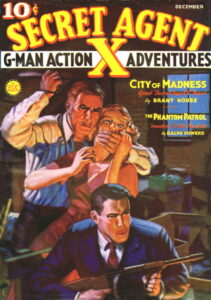 Early on, Agent X was assisted by a handful of supporting characters, including Betty Dale, the orphaned daughter of a police captain who was killed in action. X was a friend of her father’s and helped her complete school and land a job as a reporter at the Herald newspaper, where she assisted in the Agent’s activities. Jim Hobart and later Harvey Bates acted as agents of X, even if they never realized who it was that was leading them. Dr. Malcom Balmer, who had treated X for a severe injury during the war, provided medical assistance as needed. But as the series progressed, these characters — except for K9 — faded away, leaving Agent X often alone in his war against evil.
Early on, Agent X was assisted by a handful of supporting characters, including Betty Dale, the orphaned daughter of a police captain who was killed in action. X was a friend of her father’s and helped her complete school and land a job as a reporter at the Herald newspaper, where she assisted in the Agent’s activities. Jim Hobart and later Harvey Bates acted as agents of X, even if they never realized who it was that was leading them. Dr. Malcom Balmer, who had treated X for a severe injury during the war, provided medical assistance as needed. But as the series progressed, these characters — except for K9 — faded away, leaving Agent X often alone in his war against evil.
Secret Agent X reached its zenith under Fleming-Roberts with “City of Madness” (December 1936), according to the late Tom Johnson, a long-time pulp fan and historian. In his fanzine Echoes, Johnson wrote:
“City of Madness” comes at the peak of Roberts’ involvement with the Secret Agent X series. The series was now his, though there were single series by Chadwick, which had probably been written prior to Fleming-Roberts taking over the series in June 1935. Roberts was improving the series: better plots, action, and characterization. Agent X began taking on form and substance in his stories — previously the Agent had merely been a “paper” character, with little reality. Paul Chadwick had delved too deeply into the mood of horror in his stories and the characterization suffered. Roberts maintained this melodramatic mood, but at the same time improving plot and character study. Secret Agent X was finally coming to life through the efforts of G.T. Fleming-Roberts.
“City of Madness,” unfortunately, was a turning point in the Secret Agent X magazine. With this issue the subtitle is changed to “G-Man Action Adventures,” a G-man trend that was influencing many publications at this time. It was also the 11th Roberts novel in the Secret Agent X series; his next entry, the 12th, was “Death’s Frozen Formula” (February 1937) — this entry would be the last true effort on Roberts’ part to improve the series.
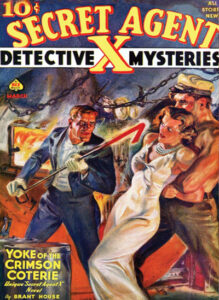 For much of the run, Agent X stood apart from other hero-pulp characters by not having an identity of his own. While other hero-pulp characters — The Shadow, Doc Savage, The Spider, Operator #5, etc. — had recognizable traits and personalities that readers could associate with, Agent X was a blank slate. Most of the time, X appeared in disguise, adopting the personality of the character he had assumed. In addition to adopting the disguise of another character in the story, Agent X sometimes fell back on stock disguises, such as A.J. or H.J. Martin, rich philanthropist Elisha Pond, or Mr. Robbins. While Secret Agent X was publisher A. A. Wyn’s longest-lasting hero pulp, the lack of a singular, identifiable personality may have prevented readers from connecting with the character and contributed to the magazine running for only five years.
For much of the run, Agent X stood apart from other hero-pulp characters by not having an identity of his own. While other hero-pulp characters — The Shadow, Doc Savage, The Spider, Operator #5, etc. — had recognizable traits and personalities that readers could associate with, Agent X was a blank slate. Most of the time, X appeared in disguise, adopting the personality of the character he had assumed. In addition to adopting the disguise of another character in the story, Agent X sometimes fell back on stock disguises, such as A.J. or H.J. Martin, rich philanthropist Elisha Pond, or Mr. Robbins. While Secret Agent X was publisher A. A. Wyn’s longest-lasting hero pulp, the lack of a singular, identifiable personality may have prevented readers from connecting with the character and contributed to the magazine running for only five years.
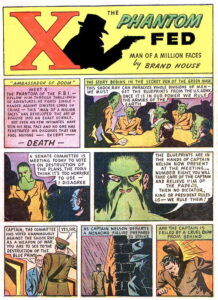 The March 1939 story wouldn’t be Agent X’s final adventure. He would appear in Wyn’s Sure-Fire Comics as X, the Phantom Fed, in 1940. And 56 years later, in 1996 and ’97, Tom and Virginia Johnson’s Classic Pulp Fiction Stories would revive the character with new stories “in the classic pulp tradition” written by “Brant House,” Stephen Payne, and Steven G. Mitchell. Payne would go on to write two more Agent X stories for the Johnsons’ Double Danger Tales in 1997 and ’98; Lance Curry would contribute a Secret Agent X and The Moon Man team-up for the same publication in 2000. Beginning in 2013, “New Pulp” publisher Airship 27 would pick up the character. To date, the company has released six volumes of stories featuring “The Man of a Thousand Faces.”
The March 1939 story wouldn’t be Agent X’s final adventure. He would appear in Wyn’s Sure-Fire Comics as X, the Phantom Fed, in 1940. And 56 years later, in 1996 and ’97, Tom and Virginia Johnson’s Classic Pulp Fiction Stories would revive the character with new stories “in the classic pulp tradition” written by “Brant House,” Stephen Payne, and Steven G. Mitchell. Payne would go on to write two more Agent X stories for the Johnsons’ Double Danger Tales in 1997 and ’98; Lance Curry would contribute a Secret Agent X and The Moon Man team-up for the same publication in 2000. Beginning in 2013, “New Pulp” publisher Airship 27 would pick up the character. To date, the company has released six volumes of stories featuring “The Man of a Thousand Faces.”
At this year’s PulpFest, we’ll salute the 90th anniversary of Secret Agent X and other great spy heroes from the pulps. We hope you will join us from August 1 – 4 at the DoubleTree by Hilton Pittsburgh — Cranberry in Mars, Pennsylvania for “Spice, Spies, Shaw, and More” at PulpFest 2024.
Our featured image is excerpted from Norman Saunders’ original art for the cover of the June 1938 issue of Secret Agent X, illustrating the short novel “The Corpse That Murdered,” written by G. T. Fleming-Roberts. Saunders also painted the cover for the final issue of the Ace Hero pulp, dated March 1939, illustrating Fleming-Roberts’ novella, “Yoke of the Crimson Coterie.”
Our lead image is the first issue of Secret Agent X, dated February 1934 and featuring cover art by J. George Janes. The artist also contributed the cover art for the August 1934 issue, featuring Emile C. Tepperman’s first of four Secret Agent X stories, “Hand of Horror.”
G. T. Fleming-Roberts wrote over half of the lead novels for A. A. Wyn’s Secret Agent X. His first, “The Corpse Cavalcade,” ran in the June 1935 number. The series would hit its peak with “City of Madness,” also penned by Fleming-Roberts. It appeared in the December 1936 issue with cover art by William Luberoff.
After the demise of the Secret Agent X pulp, Ace revived the character for its line of comic books. Appearing as “X, the Phantom Fed,” the character appeared in four issues of Sure-Fire Comics and a single issue of Lightning Comics. The page reproduced here is from Sure-Fire Comics#1, dated June 1940. Credited to Brand House, it’s an adaptation of Paul Chadwick’s “Ambassador of Doom,” from the May 1934 issue of Secret Agent X. The story is thought to have been written by Robert Turner and drawn by George Appel.
To learn more about Secret Agent X, please visit the PulpFest YouTube channel at https://www.youtube.com/@pulpfest for Craig McDonald’s video on “The Man of a Thousand Faces.” It’s part of our continuing series on “The Great Pulp Heroes.” You can watch Craig’s film by clicking the arrow below or at https://youtu.be/A0Bbi4fnIDk.
And be sure to subscribe to the PulpFest channel for all of our upcoming videos.
Kenneth Grant is a writer and popular culture enthusiast who began writing for our website in 2022. He particularly enjoys the hero pulps and also enjoys reading the latest in pulp-inspired fiction.

